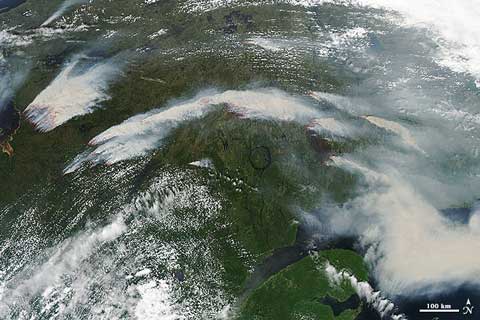Massive forest fires are raging beyond control in Quebec, sending huge plumes of smoke to the east. The Eastmain fire — top left in this image from NASA’s Earth Observatory — is spreading towards the east coast of James Bay, the southernmost extension of Hudson Bay, and is currently estimated to cover an area of 656,000 hectares (1.6 million acres). Smoke from the huge fires has already caused smog problems in Montreal and Maine, and is heading round the globe. On July 8 NASA’s Terra satellite spotted a great swathe of Canadian smoke crossing Norway and Sweden, and heading across the Baltic towards Finland.

The Eastmain fire is the largest wildfire in Canada since 1959, and is almost as big as all the wildfires that have burned in the US so far this year. Forecasts for the area show warm temperatures continuing for at least another 5 days, so the fire is likely to continue to spread.
Meanwhile, up on the Greenland ice sheet, Jason Box, Peter Sinclair and the Dark Snow team, who are investigating the effect of smoke particles deposited on the ice on melting, have successfully completed their first sampling mission. It’s well worth checking Sinclair’s blog for frequent updates — and lovely images — of the team’s progress.
[Update 14/7: Jeff Masters posts on the Canadian fires here, and a European team track the smoke in near real time.]


Data compiled by Natural Resources Canada on total area burned in Canada’s forests 1970 – 2008 is shown on the second chart on this page. The peak year in the dataset was 1989 when more than 8 million hectares burned. The ten year average 2001-2010 seems to be around 3 million hectares. I couldn’t find 2012 or 2013 data.
This is a problem that needn’t be. If forests were planted within a vast network of fire resistant fast growing and carbon sucking Sequoia sempervirens then these fires could be contained to small areas.
Does anyone know if we have native species that are relatively fire resistant. Is totara useful in this regard?
I doubt whether sequoia would grow as well in the middle of the Canadian taiga as they do in their home range on the Pacific coast. I read that they rely not just on the abundant rainfall there, but also on the fertiliser from thousands of salmon swimming up the streams there and getting turned into bear poo.
Thanks John.
If what you say is true then they shouldn’t grow very well in Canterbury’s dry climate, and yet surprisingly they do, they grow like a weed on poor soils, and to monstrous heights.
http://bioweb.uwlax.edu/bio203/s2009/hemmeric_nata/More%20Interesting%20Facts.htm
I think the major drawback is that some people don’t like the idea of a permanent forest sink where they don’t get to chop it down for profit.